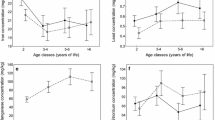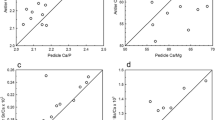Abstract
Fluoride was measured in femurs of black-crowned night-herons (Nycticorax nycticorax) living adjacent to a phosphate processing complex near Pocatello, Idaho. Fluoride (ash wt.) in femurs ranged from 540 μg/g to 11,000 μg/g and increased (P=0.0001) with age, but with no difference (P=0.80) between sexes. Adult males (⩾4 years) contained 5,409 μg/g compared to 6,042 μg/g for adult females. The tibiotarsus (=tibiae in text) increased in diameter with age (P=0.015) in this study; fluoride was nearly related (P=0.065) to the increase. As the diameter increased with age, wall thickness decreased (P=0.011) suggesting excessive internal bone resorption, but fluoride concentrations were not implicated in the relationship (p= 0.64). The apparent increase in diameter and decrease in wall thickness may have partially neutralized each other's effects on strength. Although significantly higher concentrations of fluoride were present in adults than in Third Year herons, no significant change in bone strength (maximum load or modulus of rupture) was detected between the two age classes, but three of the four comparisons showed adults with less strength (i.e., a hint of diminished strength with age). The tibiae of Hatch Year birds were significantly weaker than documented in older age classes, but incomplete growth was thought responsible. The strong relationship between age and fluroide concentrations reduced our ability to separate a “fluoride effect” from an “age effect.” Other authors believed fluoride was responsible for an increase in bone diameter and the fluoride residues encountered in adults were within the range indicative of poisoning in cattle. In addition, the adult night-herons had about 1.6 times higher fluoride concentrations than owls which showed reduced reproductive success under laboratory conditions.
Similar content being viewed by others
References
Anonymous (1975) Fluorine studies in the Pocatello area 1975. Dept Bacteriol and Biochem, College of Agric, Univ of Idaho, Moscow, ID
— (1977) Instruction manual for fluoride electrode, Model 96-09, Orion Research Inc., Cambridge, MA
Blevins RD (1979) Formulas for natural frequency and mode shape. Van Nostrand Reinhold Co, New York, 492 pp
Britton LJ, Goddard KE, Briggs JC (1983) Quality of rivers of the United States, 1976 water year—based on the Natural Stream Quality Accounting Network (NASQAN). US Geol Surv Open-File Rept. 80-594, Reston, VA, 423 pp
Chan MM, Rucker RB, Zeman F, and Riggins RS (1973) Effect of fluoride on bone formation and strength in Japanese quail. J Nutr 103:1431–1440
Church DC, Smith GE, Fontenot JP, and Ralston AT (1971) Digestive physiology and nutrition of ruminants, vol. 2-Nutrition: DC Church, Publisher, Corvallis, OR, 693 pp
Church LE, Johnson LC (1964) Growth of long bones in the chicken. Am J Anatomy 114:521–538
Cimasoni G (1970) Fluoride and Enzymes. In: Fluoride in Medicine, (Vischer TL ed.), pp 14–26, Hans Huber Publishers, Bern
Clapp RB, Klimkiewicz MK, Kennard JH (1982) Longevity records of North American birds: Gaviidae through Alcidae. J Field Ornithol 53:81–124
Gere JM, Timoshenko SP (1984) Mechanics of materials, 2nd ed. PWS Engineering, Boston, MA, 762 pp
Henny CJ, Blus LJ (1986) Radiotelemetry locates wintering grounds of DDE-contaminated black-crowned night-herons. Wildl Soc Bull 14:236–241
Hodge HC, Smith FA (1965) Fluorine chemistry. Volume 4. Academic Press, New York
Hoffman DJ, Pattee OH, Wiemeyer SN (1985) Effects of fluoride on screech owl reproduction: teratological evaluation, growth, and blood chemistry in hatchlings. Toxicol Letters 26:19–24
Kay CE, Tourangeau PC, Gordon CC (1975) Fluoride levels in indigenous animals and plants collected from uncontaminated ecosystems. Fluoride 8:125–133
—, —, — (1976) Population variation of fluoride parameters in wild ungulates from the western United States. Fluoride 9:73–90
Krook L, Maylin GA (1979) Industrial fluoride pollution. Trace Substances in Environmental Health XIII A symposium. Hemphill DD (Ed.) University of Missouri, Columbia
Kubota J, Naphan EA, Oberly GH (1982) Fluoride in thermal spring water and in plants of Nevada and its relationship to fluorosis in animals. J Range Manage 35:188–192
Merkley JW (1976) Increased bone strength in coop-reared broilers provided fluoridated water. Poultry Sci 55:1313–1319
— (1981) The effect of sodium fluoride on egg production, egg quality, and bone strength of caged layers. Poultry Sci 60:771–776
Merkley JW, Wabeck CJ (1975) Cage density and frozen storage effect on bone strength of broilers. Poultry Sci 54:1624–1627
Minshall GW, Andrews DA (1973) An ecological investigation of the Portneuf River, Idaho: A semiarid-land stream subjected to pollution. Freshwater Biology 3:1–30
National Academy of Sciences (1974) Effects of fluorides in animals. Committee on Animal Nutrition, subcommittee on Fluorosis. Nat Acad Sci, Washington, DC, 70 pp
Neuman WF, Neuman MW, Main ER, O'Leary J, Smith FA (1950) The surface chemistry of bone II. Fluoride deposition. J Biol Chem 187:655–661
Oberleas D, Prasad AS (1969) Adequacy of trace minerals in bovine milk for human consumption. Am J Clin Nutr 22:196–199
Pattee OH, Wiemeyer SN, Swineford DM (1988) Effects of dietary fluoride on reproduction in Eastern Screech-owls. Arch Environ Contaim Toxicol 17:213–218
Phillips PH, Suttie JW (1960) The significance of time in intoxication of domestic animals by fluoride. AMA Arch Ind Health 21:343–345
Riggins RS, Zeman F, Moon D (1974) The effects of sodium fluoride on bone breaking strength. Calcium Tissue Res 14:283–289
SAS Institute (1985) SAS Users Guide: Statistics. Version 5 edition, SAS Institute Inc., Cary, NC, 956 pp
Seel DC, Thomson AG (1984) Bone fluoride in predatory birds in the British Isles. Environ Pollut (Series A) 36:367–374
Shupe JD (1980) Clinicopathologic features of fluoride toxicosis in cattle. J Animal Sci 51:746–758
Shupe JD, Alther EW (1966) The effects of fluorides on livestock with particular reference to cattle. In: Eichler O, Farah A, Herken H, Welch A, Smith F (eds) Handbook of environmental pharmacology, volume 20, part 1, Springer-Verlag, New York
Shupe JD, Miner ML, Greenwood DA, Stoddard GE (1963) The effect of fluorine in dairy cattle. II. Clinical and pathological effects. Am J Vet Res 24:964–969
Singer L, Armstrong WD (1968) Determination of fluoride in bone with the fluoride electrode. Anal Chem 40:613–614
Stewart DJ, Manley TR, White DA, Harrison DL, Stringer EA (1974) Natural fluoride levels in Bluff area, New Zealand. I. Concentrations in wildlife and domestic animals. New Zealand J Sci 17:105–113
Suttie JW, Hamilton RJ, Clay AC, Tobin ML, Moore WG (1985) Effects of fluoride ingestion on white-tailed deer (Odocoileus virginianus). J Wildl Dis 21:283–288
Wainwright SA, Biggs WD, Currey JD, Gosline JM (1976) Mechanical design in organisms. John Wiley, New York, 423 pp
Weatherell JA, Weidmann SM (1959) The skeletal changes of chronic experimental fluorosis. J Pathol Bacteriol 78:233–241
Wolinsky I, Simkin A, Guggenheim K (1972) Effects of fluoride on metabolism and mechanical properties of rat bone. Am J Physiol 223:46–50
Author information
Authors and Affiliations
Rights and permissions
About this article
Cite this article
Henny, C.J., Burke, P.M. Fluoride accumulation and bone strength in wild black-crowned night-herons. Arch. Environ. Contam. Toxicol. 19, 132–137 (1990). https://doi.org/10.1007/BF01059821
Received:
Revised:
Issue Date:
DOI: https://doi.org/10.1007/BF01059821




